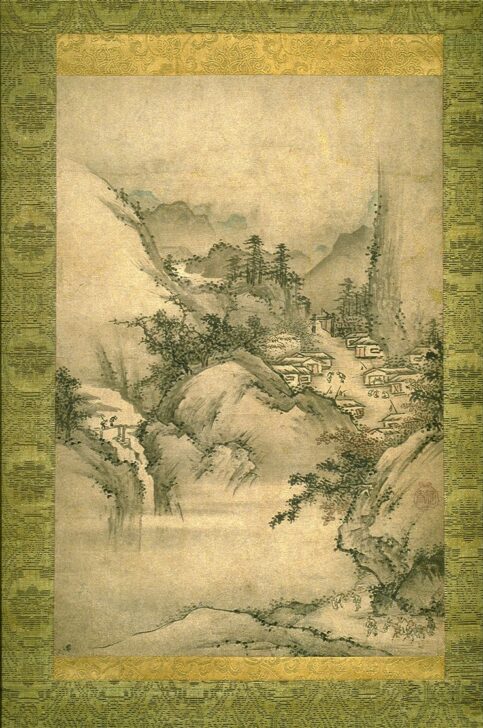Mist Clearing Over a Mountain Village, formerly attributed to Hasegawa Nobuharu (Shinshun; later, Tôhaku)
Japanese

Description
This small village tucked in the mountains is brimming with life. Travelers carry loads with pack animals on the bottom right, and two figures trudge across a waterfall bridge with their backs bent—indicating the weight of old age or hard work. The theme of meeting recurs in the painting, as figures bow to one another in both the foreground and middleground. The majestic mountains tower upwards and seem to disappear in the skillfully suggested mist. In the background, mountain peaks created by subtle washes of blues recede into the distance.
This painting was once attributed to Hasegawa Nobuharu (Tôhaku), one of most celebrated painters of the Momoyama Period, whose large workshop of artists decorated the walls and screens of castles occupied by flamboyant military leaders. The rocky outcroppings and dotted outlines in this painting reveal his style, but it is more likely that this work was done by one of his pupils.
(Japanese Gallery Rotation, Fall 2010)
Gallery Rotation Fall 2010
Formerly attributed to Hasegawa Nobuharu (Tôhaku)
Japan, 1539–1610
Mist Clearing Over a Mountain Village
Japan, Momoyama Period (1583–1615)
late 16th–early 17th century
Hanging scroll, ink, and light color on paper
Museum purchase made possible by the Margaret Watson Parker Art Collection Fund, 1967/2.5
This small village tucked in the mountains is brimming with life. Travelers carry loads with pack animals on the bottom right, and two figures trudge across a waterfall bridge with their backs bent—indicating the weight of old age or hard work. The theme of meeting recurs in the painting, as figures bow to one another in both the foreground and middleground. The majestic mountains tower upwards and seem to disappear in the skillfully suggested mist. In the background, mountain peaks created by subtle washes of blues recede into the distance.
This painting was once attributed to Hasegawa Nobuharu (Tôhaku), one of most celebrated painters of the Momoyama Period, whose large workshop of artists decorated the walls and screens of castles occupied by flamboyant military leaders. The rocky outcroppings and dotted outlines in this painting reveal his style, but it is more likely that this work was done by one of his pupils.
Subject Matter:
This painting was once attributed to Hasegawa Nobuharu (Tôhaku), one of most celebrated painters of the Momoyama Period, whose large workshop of artists decorated the walls and screens of castles occupied by flamboyant military leaders. The rocky outcroppings and dotted outlines in this painting reveal his style, but it is more likely that this work was done by one of his pupils.
Physical Description:
This is a vertical format painting surrounded by green and gold fabric. It is painted in tones of black with some areas of pink and blue color. It depicts a landscape scene with a cluster of small houses nestled in a craggy mountainous area. There is a river that runs through the landscape with two figures crossing a small footbridge. Other figures are shown in the open area of the village. The trees and vegetation are painted with short abbreviated brushstriokes.
Usage Rights:
If you are interested in using an image for a publication, please visit https://umma.umich.edu/request-image/ for more information and to fill out the online Image Rights and Reproductions Request Form.